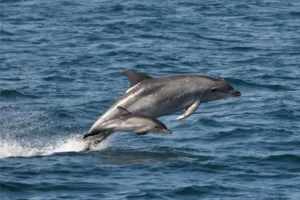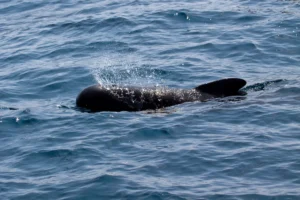The coast of Catalonia and the Balearic Islands, in the Mediterranean, are areas of remarkable marine biodiversity, including the presence of various cetaceans, such as bottlenose dolphins, striped dolphins, pilot whales, fin whales and, although more rarely, Cuvier’s whales.

Bottlenose dolphins (Tursiops truncatus): These are perhaps the best known and easily identifiable cetaceans due to their considerable size, playful behavior and frequent presence near the coast. In the waters of Catalonia and the Balearic Islands, bottlenose dolphins are common and can often be observed in groups, interacting with each other and with boats. Their adaptability to the environment and varied diet allows them to thrive in these areas.

Striped dolphins (Stenella coeruleoalba): Smaller than bottlenose dolphins, these dolphins are recognizable by the stripes or stripes that adorn their bodies. They are extremely gregarious animals and are often seen in large groups, performing acrobatics and swimming at high speed. In the waters of Catalonia and the Balearic Islands, they are frequent and adapt to a wide variety of marine habitats.

Pilot whales (Globicephala melas): Also known as pilot whales, pilot whales are larger, more robust cetaceans. They prefer deep waters and, although their sighting near the coast is not common, they can be observed in waters farther off the Balearic Islands, where the depths allow their lifestyle and diet based on squid and deep sea fish.

Fin whales (Balaenoptera physalus): Among the cetaceans that visit these waters, the fin whale is the most impressive for its size, being the second largest animal on the planet after the blue whale. Their presence in Catalonia and the Balearic Islands is usually a remarkable event, given their impressive stature and elegant behavior. These giants migrate and are sighted with some regularity, especially during the seasons when the waters are richer in plankton, their main food source.

Cuvier’s whales (Ziphius cavirostris): These are the most elusive and least understood of the cetaceans mentioned, given their rare appearances and deep-sea habits. Cuvier’s whales can dive to impressive depths, which makes them very difficult to study and observe. In Catalonia and the Balearic Islands, sightings are exceptional and generally occur only when the animal becomes disoriented or ill.
In conclusion, the waters off the coast of Catalonia and the Balearic Islands are rich in marine life, including a fascinating variety of cetaceans. These species not only enrich the biodiversity of the area, but are also crucial to the ecological balance and represent an important tourist attraction for the region. Observing these magnificent animals, from playful dolphins to majestic fin whales, offers a breathtaking natural spectacle and highlights the importance of preserving these marine habitats.
Respect above all else
Respecting the distance, avoiding feeding cetaceans or chasing them from a boat are fundamental practices for the conservation of these animals and the maintenance of healthy marine ecosystems. Inappropriate human interaction with cetaceans can have significant negative consequences for both animals and humans.
Maintaining an appropriate distance ensures that cetaceans can continue their natural activities, such as feeding, socializing and rearing their young without stress or interruption. Excessive proximity can cause stress and alter natural behaviors, leading animals to abandon important feeding or breeding areas.
Avoiding feeding cetaceans is crucial because it can alter their natural feeding habits, make them dependent on humans and increase the risk of disease. Food provided by humans is often not suitable for their diet and can cause health problems. In addition, waiting for food from boats can expose animals to hazards such as collisions with boats or entanglement with fishing gear.
Not chasing cetaceans with boats is important to avoid the risk of physically injuring them or altering their migratory and feeding patterns. The chase can cause them extreme stress, exhaustion and, in severe cases, can lead to death. In addition, boats moving at high speed near cetaceans can injure or kill them by collision.
In addition to ethical and conservation reasons, there are regulations and laws in many places, including the coast of Catalonia and the Balearic Islands, that set specific guidelines on how people should behave around cetaceans. These laws are designed to protect animals and ensure that they can live in a safe and healthy environment.
In summary, respecting the distance, not feeding cetaceans, and avoiding chasing them with boats are essential practices for the protection of these marine beings. These actions not only benefit the animals, but also contribute to the health of marine ecosystems and foster a more sustainable and respectful relationship between humans and marine life.
+info:
El cap d’olla gris al Mediterrani (The gray pot in the Mediterranean)
Rorqual Project
Cetàcea Association
Gencat. Protected and threatened species
Environmental services and marine services
Image Credits: istockphoto





